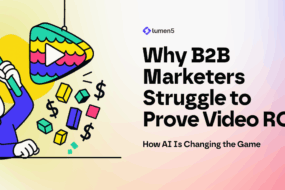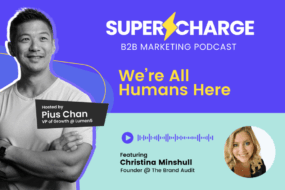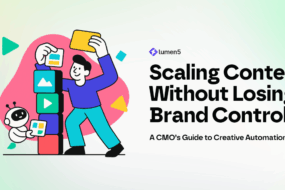If your go to market approach still assumes that revenue begins when a salesperson picks up the phone, you are already behind. Over the past two decades the B2B buying process has changed completely. Buyers now expect to self educate long before they speak with a vendor and that means content is the new front door to your business.
At Lumen5, we recently explored this shift during a conversation between our VP of Revenue & Head of Growth, Pius Chan, and our Global Head of Enterprise Sales, Thomas Klinger. Their insights reveal how marketing, sales, and customer experience must realign around a content led buyer’s journey and why an AI video creation platform like Lumen5 makes this strategy scalable across teams.
This article breaks down what has changed, why it matters, and how you can operationalize a content led, video first approach today.
- The Shift From Sales Led to Content Led Buying
- What a Content Led Buyer’s Journey Really Looks Like
- Marketing Must Become a Revenue Engine
- The Right Order: Revenue Marketing, Product Marketing, Brand Marketing
- Aligning Sales, Marketing and CX Around One Revenue Goal
- How AI Video Creation Supports a Content Led GTM Model
- How to Put This Into Practice
- Frequently Asked Questions
- 1. What is a content led buyer’s journey?
- 2. How does marketing contribute to revenue in this model?
- 3. Why is video essential across the entire journey?
- 4. How does Lumen5 help sales, marketing, and CX alignment?
- 5. What steps should companies follow to adopt this model?
- 6. How does customer experience fit into a content led GTM?
- Conclusion
The Shift From Sales Led to Content Led Buying
When Pius began selling office equipment in the early 2000s, sales controlled the entire buying journey. He spent his days walking into office buildings, dropping off brochures, and speaking directly with receptionists and office managers. The seller held all the information, so buyers depended on sales reps to understand options, pricing, and features.
Today buyers behave very differently. They research independently, evaluate anonymously, and often reach out to sales only after forming a strong preference. Analyst firm Gartner confirms this in their guide to the B2B Buying Journey.
Pius highlights three forces driving this shift:
Generational change. Millennial and Gen Z buyers prefer autonomy, self education, and asynchronous research. They avoid unscheduled calls and depend heavily on digital content.
Technology and information access. Buyers now have instant access to peer reviews, landing pages, explainer videos, social content, and AI research assistants who can summarize and compare options instantly.
A crowded vendor landscape. Buyers face far more choices than ever before and often purchase as committees. They do not have time to sit through a dozen sales calls just to gather basic information.
The result is a buyer who expects content, not cold calls, to guide them.
What a Content Led Buyer’s Journey Really Looks Like
A content led buyer’s journey reflects how modern buyers research, evaluate, and validate solutions long before they engage with sales. They expect to discover insights at their own pace, compare options with ease, and involve internal stakeholders as needed. For this reason, marketing must guide the entire journey rather than only handling awareness.
A helpful structure for understanding the journey comes from The Insight Collective’s breakdown of Mapping Content to the Buyer’s Journey.

Awareness
In this stage, buyers recognize a challenge but have not yet connected it to a specific category or vendor. Your content should help them understand the pain and the impact it has on their work. For instance, a marketer who struggles with slow video production is looking for easier ways to scale content creation, not a specific product like Lumen5. Awareness content should clarify the problem and introduce potential approaches.
Consideration
Once the problem is defined, buyers begin exploring types of solutions. They want to understand what categories exist and what criteria matter. Educational content such as comparisons, category explainers, and practical use cases helps them evaluate options and narrow their list.
Decision
At this point, buyers are selecting a partner. They need confidence in your product’s capabilities and reassurance that onboarding will be smooth. Case studies, ROI examples, product walkthroughs, and customer stories give them the credibility they need to advocate internally and finalize their decision.
Onboarding and Value Realization
After purchase, the focus shifts to achieving the outcomes that motivated the decision. Strong onboarding, training videos, and best practice content help customers adopt the product quickly and realize value. This stage often determines whether customers become long term users.
Advocacy and Expansion
Customers who experience meaningful value naturally move into advocacy. They renew, expand usage, share positive feedback, and refer others. Content at this stage reinforces ongoing success and deepens the relationship.
These principles align with broader industry perspectives on buyer led content, including Liftloop’s insights on The Future of Buyer Led Content.
Marketing Must Become a Revenue Engine
One of Pius’s most important insights is this: marketing that cannot demonstrate revenue impact becomes an arts and crafts function.
Marketing must be accountable for pipeline and revenue influence. Its role extends beyond brand and awareness into driving demand that converts.
A practical approach is to:
- Start with your company’s annual revenue target.
- Reverse engineer the pipeline needed using your historical close rate.
- Assign specific pipeline creation goals to marketing versus outbound sales.
- Tie marketing KPIs to pipeline generating activities such as email signup growth, demo requests, MQLs, SQLs, and influenced revenue.
This alignment ensures marketing contributes directly to growth instead of orbiting around it.
The Right Order: Revenue Marketing, Product Marketing, Brand Marketing
Many companies struggle because they invest heavily in brand activity before establishing the fundamentals that drive measurable growth. Pius emphasizes that successful marketing maturity follows a clear sequence. Each stage builds the stability and clarity required for the next, and skipping ahead often leads to wasted resources and inconsistent results.

Step 1: Build a Revenue Marketing Engine
Revenue marketing forms the foundation of a modern go to market strategy. This stage ensures that your systems, attribution, and funnel structure connect marketing activity to pipeline and revenue. It involves establishing reliable lead tracking, defining funnel stages, aligning with sales on qualification criteria, and building a clear understanding of how your demand translates into actual revenue. Without this layer, teams cannot make informed decisions about what works and what needs to change.
Step 2: Strengthen Product Marketing
Once your revenue engine is solid, product marketing becomes essential. This step focuses on clarifying what you offer, who you serve, and why your solution matters. Strong product marketing ensures that messaging is accurate, relevant, and aligned with buyer expectations. It also enables sales through positioning, competitive intelligence, customer insights, and content that resonates with real challenges. Without strong product marketing, awareness efforts bring traffic but fail to convert.
Step 3: Scale Brand Marketing
Brand marketing becomes powerful only when the underlying structure is healthy. With clear messaging and a measurable revenue engine in place, brand initiatives can amplify your presence, deepen emotional connection, and strengthen long term trust. Brand becomes an accelerator rather than a distraction. At this stage, companies can confidently invest in large creative campaigns, events, partnerships, and high visibility storytelling because they can tie the impact back to pipeline and customer growth.
Following this progression protects organizations from over investing in brand before the fundamentals are in place, ensuring both short term performance and long term brand strength.
Aligning Sales, Marketing and CX Around One Revenue Goal
Alignment is a competitive advantage. Research by Harvard Business Review shows that a better way to link sales and marketing.
Sales, marketing, and CX must coordinate around:
- Shared KPIs
- Shared messaging
- Shared definitions of success
- Unified content system that supports the entire lifecycle
CX’s influence is substantiated by Qualtrics’ research showing that customer experience directly drives loyalty and retention.
How AI Video Creation Supports a Content Led GTM Model
Video is now the most effective format across the buyer journey. Wyzowl’s annual Video Marketing Report consistently shows that video improves understanding, increases conversions, and influences buying decisions.
AI video creation platforms like Lumen5 help teams scale video output without traditional production constraints. With AI-assisted storyboarding, templates, and brand controls, teams can quickly create consistent, polished video content.
Explore Lumen5 tools here:
Video supports every function:
- Marketing: convert blogs into videos, repurpose webinars, create social clips.
- Sales: create personalized outreach, product walkthroughs, and micro demos.
- CX and L&D: create training, onboarding, and best practice videos.
This unified video strategy strengthens the entire go to market model.
How to Put This Into Practice

Creating a content led, video first strategy requires more than publishing occasional assets. It demands a structured, measurable system that supports how modern B2B buyers research and make decisions.
Begin by clarifying your revenue and pipeline targets. This means defining your annual revenue goal, calculating the pipeline required to achieve it, and assigning clear ownership across marketing and sales. Gartner’s research highlights why predictable pipeline modeling improves overall go to market performance, as outlined in their analysis on B2B Pipeline Forecasting.
Once revenue expectations are solid, map your buyer journey. That includes documenting the questions, fears, motivations, and evaluation criteria your audience experiences at each stage. Resources from the Content Marketing Institute, such as their guide to Developing a Customer Journey Map, offer proven frameworks for structuring these insights.
After mapping the journey, audit your existing content. Many teams discover an imbalance: plenty of awareness content but limited consideration and decision stage assets. Mid-funnel gaps often include missing comparison guides, category explainers, and product walkthroughs. Bottom-of-funnel gaps often include missing case studies, ROI explanations, onboarding support, and customer education. These are essential for building trust and moving buyers toward confident decisions.
Next, define stage specific KPIs that match your journey map. HubSpot’s performance measurement guidance provides a useful foundation for understanding which metrics truly influence revenue. Their resource on How to Report on Marketing Performance explains how to connect KPIs to pipeline creation and conversion.
Establishing a formal customer listening program ensures your content and messaging remain anchored in real user behavior. Gainsight’s essential guide to customer success, particularly their insights on Company-Wide Customer Success, outlines why retention and customer understanding are strategic growth levers. Speaking with new customers, long-term advocates, and churned accounts gives your team insight into expectations, friction points, and the moments that matter most.
Finally, build a scalable video workflow so your teams can execute consistently. AI powered video tools like Lumen5 enable marketing, sales, CX, and L&D teams to create on brand videos without relying on complex production cycles. Video enhances every part of the buyer journey, and industry benchmarks such as Wyzowl’s annual Video Marketing Statistics Report reinforce that video increases understanding, engagement, and conversion across the funnel.
This combination of revenue clarity, buyer insight, measurement discipline, customer listening, and scalable video production gives your organization a durable, aligned, and highly effective content led GTM motion.
Frequently Asked Questions
1. What is a content led buyer’s journey?
It is a buyer journey where customers rely on content to educate themselves long before speaking with sales. Marketing, sales, and CX must support every stage with helpful, relevant content.
2. How does marketing contribute to revenue in this model?
Marketing must drive qualified pipeline, not just awareness. This includes nurturing intent, enabling buyers with educational content, and partnering with sales on measurable KPIs.
3. Why is video essential across the entire journey?
Video accelerates understanding, builds trust, and communicates value far faster than text. Buyers use video to validate solutions, compare options, and onboard successfully.
4. How does Lumen5 help sales, marketing, and CX alignment?
Lumen5 provides a unified platform to create consistent, on brand video content that supports awareness, education, decision support, onboarding, and training.
5. What steps should companies follow to adopt this model?
Start with revenue alignment, map the buyer journey, audit your content, define KPIs, build a listening loop, and adopt a scalable video workflow.
6. How does customer experience fit into a content led GTM?
CX ensures value realization. It uses content, especially video, to onboard customers, teach best practices, reduce churn, and drive long term loyalty.
Conclusion
The B2B buying journey has changed permanently. Buyers expect transparency, self service, and content that supports their evaluation process from start to finish.
AI video creation platforms like Lumen5 enable teams to scale high quality video content across awareness, consideration, decision, onboarding, and expansion stages.
If you want, I can also create internal link mappings for additional Lumen5 pages or generate video scripts that can be dropped directly into Lumen5 for production.






